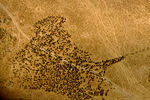The greater Cuban nesophontes (Nesophontes major) is an extinct species of eulipotyphlan that was native to Cuba. It is thought that the introduction of...
1 KB (105 words) - 03:13, 20 July 2022
Rican nesophontes (Nesophontes edithae) Cayman nesophontes (Nesophontes hemicingulus) Atalaye nesophontes (Nesophontes hypomicrus) Greater Cuban nesophontes...
6 KB (642 words) - 22:10, 4 January 2024
Islands Atalaye nesophontes Nesophontes hypomicrus Miller, 1929 Eulipotyphla early 1500s 1 Hispaniola Greater Cuban nesophontes Nesophontes major Arredondo...
45 KB (1,837 words) - 11:41, 28 September 2024
Rican nesophontes (Nesophontes edithae) Atalaye nesophontes (Nesophontes hypomicrus) Greater Cuban nesophontes (Nesophontes major) Western Cuban nesophontes...
45 KB (3,219 words) - 21:31, 4 July 2024
Cuban nesophontes, Nesophontes longirostris (E) Greater Cuban nesophontes, Nesophontes major (E) EX Western Cuban nesophontes, Nesophontes micrus (E) EX St...
174 KB (12,281 words) - 13:51, 12 September 2024
and Darrin P. Lunde. ""Last occurrence" of the Antillean insectivoran Nesophontes: new radiometric dates and their interpretation. American Museum novitates;...
71 KB (2,746 words) - 23:45, 29 September 2024
Genus: Nesophontes Atalaye nesophontes, Nesophontes hypomicrus EX Western Cuban nesophontes, Nesophontes micrus EX St. Michel nesophontes, Nesophontes paramicrus...
13 KB (1,009 words) - 11:38, 9 October 2023
and Darrin P. Lunde. ""Last occurrence" of the Antillean insectivoran Nesophontes: new radiometric dates and their interpretation. American Museum novitates;...
284 KB (18,500 words) - 15:39, 26 September 2024
Nesophontidae Genus: Nesophontes Atalaye nesophontes, N. hypomicrus EX Western Cuban nesophontes, N. micrus EX St. Michel nesophontes, N. paramicrus EX Haitian...
14 KB (1,187 words) - 08:42, 26 August 2024
List of eulipotyphlans of the Caribbean (section Cuba)
not all Nesophontes species are universally accepted as valid. However, most of these, including all Nesophontes, are now extinct; the Cuban solenodon...
12 KB (1,382 words) - 17:04, 18 February 2023
recently, nonhomologous species in the genus Nesophontes were hypothesized to be venomous. Species within Nesophontes exhibit grooved upper canines, similar...
30 KB (3,587 words) - 21:13, 15 September 2024
Family: Nesophontidae Genus: Nesophontes Western Cuban nesophontes, N. micrus EX Family: Solenodontidae Genus: Atopogale Cuban solenodon, A. cubana EN The...
15 KB (1,217 words) - 23:09, 24 September 2023
Nesophontidae, or the West Indian shrews, contained a single genus, Nesophontes, which inhabited Cuba, Hispaniola, Puerto Rico and the Cayman Islands. All members...
7 KB (743 words) - 10:09, 22 June 2023
Eulipotyphla Family Solenodontidae: (2 species) solenodons (Cuba, Hispaniola) Family Nesophontidae: nesophontes (West Indies shrews) (recently extinct) Family Soricidae:...
76 KB (6,393 words) - 21:36, 28 September 2024
Pleistocene, including all the sloths and monkeys, the unique insectivore Nesophontes, two of four species of solenodon, and a variety of rodents including...
28 KB (3,704 words) - 13:22, 14 September 2024
occurred. However, other fauna such as the endemic Antillean insectivores (Nesophontes sp., Solenodon marcanoi and others) and freshwater fish appear to have...
52 KB (5,958 words) - 14:12, 29 August 2024
Ostende & Joniak (2023). Systematic revision of the Cuban species belonging to the genus Nesophontes is published by Orihuela León (2023). Kampouridis,...
349 KB (35,179 words) - 19:35, 13 September 2024
bravoi) is published by Crowley et al. (2019). Three molar fossils of the greater bandicoot rat are described from the Middle Pleistocene of Taiwan by Kawamura...
329 KB (34,199 words) - 03:18, 27 June 2024








